Cat scratching posts are pieces of furniture designed specifically for pet cats to scratch on. It generally consists of one or more vertical posts covered in a rough, durable material that your cat can dig her claws into, such as sisal, jute, or coir.
Access to a cat scratching post is especially important for your cat since they allows the cat to sharpen and maintain her claws and relieve stress. In addition, a scratching post helps modify the cat’s behavior so that she doesn’t use your home furnishings to scratch on, which can result in expensive damage.
Cats have a natural instinct to scratch and sharpen their claws, and providing them with a specific tool to do that is essential for your pet’s well-being, as well as protecting your home furnishings from damage.
Read this guide to learn more about your feline friend’s scratching addiction, how you can keep your kitty’s claws off your sofa, and choose the best scratching post.
What Are The Benefits Of Scratching Post Training For Cats?
The benefits of scratching posts for cats are many!
Using the post helps keep your cat’s claws in good order and provides her with a stress-relieving spot of exercise that’s great for her physical and mental well-being. In addition, you can use a scratching post for cat training to correct undesirable behaviors, such as scratching your furniture.
Here’s an overview of the many benefits of providing your cat with a scratching post.
Physical Benefits
If you watch your cat playing in the garden, you’ll see her reaching up to trees, fence posts, and the like to enjoy a nice, relaxing stretch. A scratching post provides your cat with a means of exercising and stretching inside your home, which helps to tone and strengthen her muscles, promoting better flexibility and agility.
Mental Benefits
Using a scratching post can help to stimulate your cat’s mind, reduce boredom, and prevent potential behavioral problems that could arise from frustration or pent-up energy.
Claw Health
Cats need to keep their claws at an appropriate length, and they do so by scratching them against trees, fences, etc. An indoor scratching post provides your cat with the perfect toy that she can use to maintain her claws, saving you the hassle of having to trim them and preventing the risk of overgrowth or ingrown nails.
Stress Relief
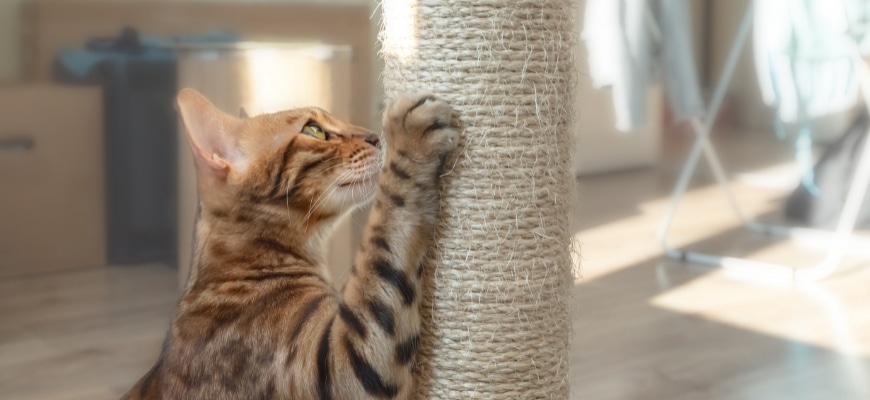
Scratching provides natural stress relief for cats, so providing your pet with a scratching post can help relieve tension and anxiety, promoting a chilled-out, calmer kitty.
Behavioral Improvement
A recent survey showed that over 80% of cat owners have experienced problems with their cat scratching furniture or carpets. Scratching post training helps to redirect your cat’s natural scratching behavior away from your home furnishings, creating a more harmonious home environment for everyone.
Territory Marking
Cats use scratching to mark their territory, and a designated scratching post in your home allows your cat to communicate with their housemates and indulge in natural behavior.
Mental Stimulation
Indoor cats can easily become bored, and an interactive scratching post offering various textures, additional toys, viewing perches, and hammocks can provide entertainment and environmental enrichment, essential for your cat’s mental well-being.
Furniture Protection
Training your cat to use a scratching post can save your furniture, floor coverings, and other valuables from damage.
Enhancing Cat-Owner Bond
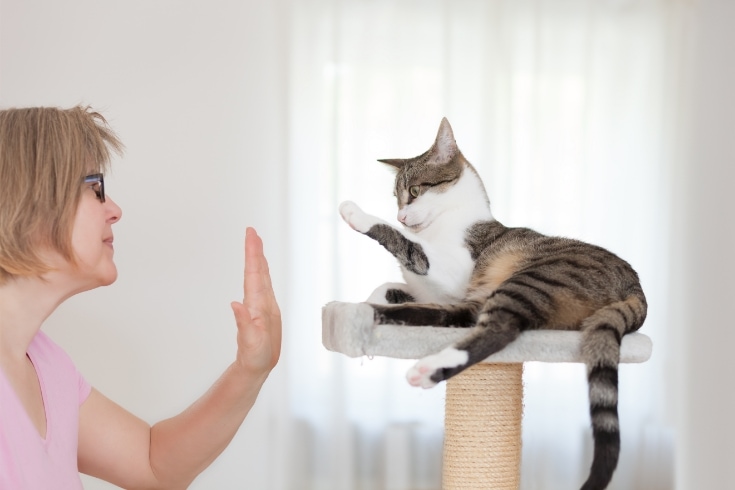
Using positive reinforcement during cat scratching post training creates a bonding experience between you and your pet because the cat associates the training process with your affection and rewards.
Increased Confidence
You can build a shy cat’s confidence by providing different scratching post options throughout your home since scratching posts are olfactory and visual symbols of territorial ownership.
Safe Indoor Environment
You can decide on a safe place to put your cat’s scratching post, preventing her from getting into mischief and potentially suffering injury by trying to scratch in inappropriate places, such as on countertops or sharp table corners.
How To Choose The Right Scratching Post
Choosing the right scratching post is essential if your cat is to gain the maximum benefit from using it.
Generally, the more you pay, the better quality the construction and materials you get, which is vital if your cat is to stay safe and the scratching post is going to last. You must choose the correct size scratching post that’s not too big to fit in your home or too small for your cat. And don’t forget to look at different designs, and fabrics, and how easy it will be to maintain the scratching post.
If your cat is reluctant to use the scratching post, you might find that one with an additional toy or catnip scent works the best.
Different Types Of Cat Scratching Posts
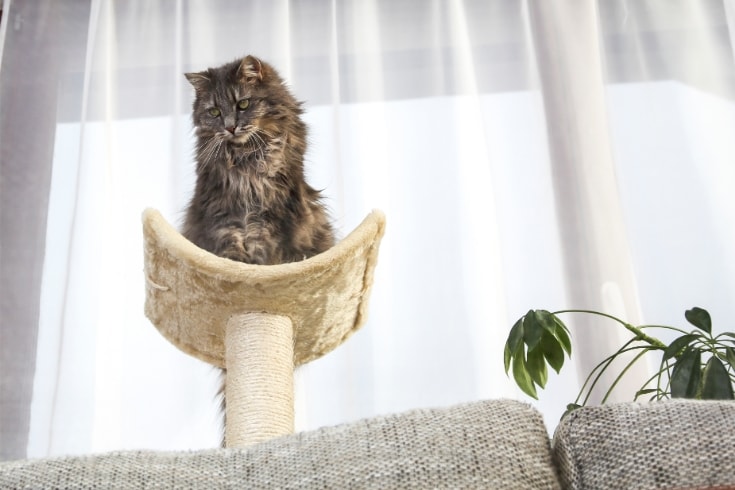
Different types of cat scratching posts are available, so you’re sure to find something perfect for your cat.
For example, you can have a single vertical post or a group of two, three, or more posts of different heights. Some scratching posts include a hanging ball or feather teaser to add an additional dimension to your cat’s enjoyment, while others feature a comfy hammock or perches at different heights so that your cat can sit and view her territory from on high.
If you have a senior cat, she might not be as agile or physically able as she once was, so a horizontal scratching post or mat could suit her better than a vertical one.
Essential Factors To Consider In Choosing A Scratching Post
The factors to consider when choosing cat scratching posts include the price, the size of the scratching post, where it will fit in your home, and the quality and durability of the post.
You also need to think carefully about how easy it will be to maintain the post and how attractive it will be to your cat.
My cats have a unit that’s a combo of cat scratching posts and padded perches, which they use on a daily basis. There’s a hammock and a hanging ball, too, neither of which my cats bother with. So, I advise choosing a scratching post that only offers features you know your cat will enjoy rather than spending extra cash on something they won’t use.
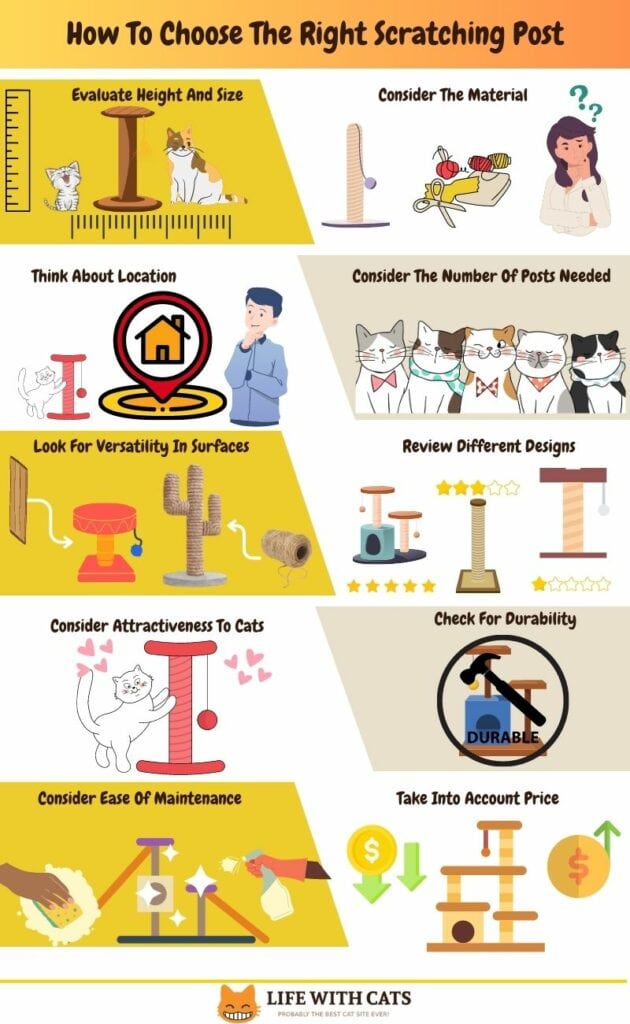
Consider The Material
The material from which the scratching post is made is critical for its durability, safety, and effectiveness. Ideally, you want a post that’s made from sturdy materials, such as cardboard, wood, jute, and sisal rope, as these provide satisfying textures for your cat to scratch and are pretty hard-wearing, so won’t wear out too quickly.
Evaluate Height And Size
The scratching post should be high enough to allow your cat to stretch fully and extend her body while she scratches but shouldn’t wobble or become unstable.
If you live in a small apartment or house, you’ll need to ensure that the scratching post doesn’t take up so much space that it’s in the way.
Think About Location
Your cat will be more likely to use her scratching post if you put it somewhere she already spends quite a lot of her time, such as a favorite napping spot. Make sure your cat can easily get to the post and has plenty of room to stretch while she’s using it.
Consider The Number Of Posts Needed
If you have a multicat home or a very large living space, you might want to consider having more than one scratching post. I have a unit that features several scratching posts and perches so that both my cats can use it, preventing territorial squabbles.
In addition, several scratching posts help to spread the load and last longer than one post that will soon get shredded and require replacement.
Review Different Designs
Cat scratching posts are available in various shapes and configurations, including single cactus posts, multiple mushrooms, and single towers, and many designs include different attached toys, hideouts, and platforms. Choose a design that fits your cat’s preferences and blends in with your home decor.
Look For Versatility In Surfaces
Some cats love to scratch on carpets, others prefer jute or sisal, and some would rather sharpen their claws on wood. So, be sure to choose a scratching post that offers your pet her preferred scratching surface.
Check For Durability
The old maxim “Buy cheap, buy twice” is certainly true when it comes to cat scratching posts! Look for a durable, hard-wearing scratching post that will withstand your cat’s scratching habits over time, saving you money and preventing the need for frequent replacements.
Consider Attractiveness To Cats
The cat scratching post you choose must be attractive to your pet or she won’t use it and might defer to sharpening her claws on your furniture instead! Many scratching posts come with features such as hanging toys, catnip pockets, or hidden treats that can attract your cat’s attention and make the scratching post more appealing to her.
Consider Ease Of Maintenance
Although cat scratching posts don’t generally require much maintenance, if you can find one that is easy to wipe clean, that’s a bonus!
Take Into Account Price
Many scratching posts are available at different price points, so you should be able to find one that balances affordability with the features your cat needs. Again, I would stress that investing in a high-quality, long-lasting product will save you money in the long term, so always go for the best scratching post you can afford.
Step-By-Step Guide To Scratching-Post Training
Now you’ve chosen the best scratching post you can find for your cat, you’ll need to train her to use it!
So, to help you succeed, here’s our step-by-step guide to scratching-post training.
Purchase An Appropriate Scratching Post
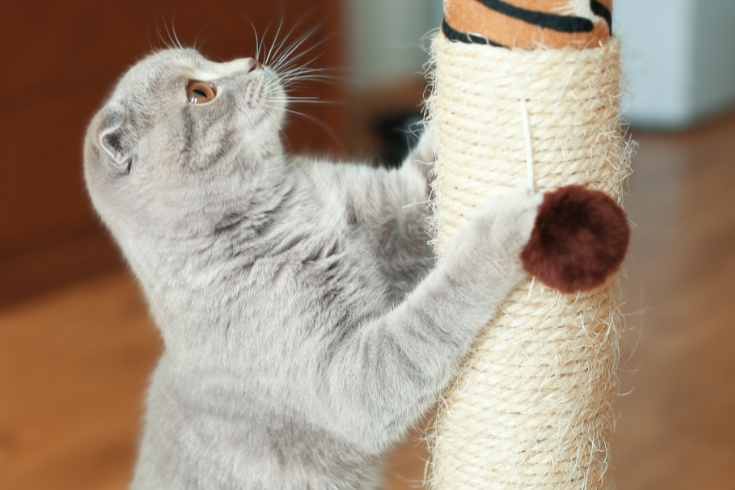
When buying a scratching post for your cat, choose one that’s covered in the material your cat most likes scratching, such as sisal or cardboard, which allows your cat to stretch out fully while scratching and is sturdy enough to withstand vigorous use.
Choose The Right Location For The Post
Locate the scratching post somewhere your cat likes to spend her time or where she tends to scratch inappropriately, e.g., walls or furniture. Cats often use scratching to mark their territory and immediately upon waking up, so consider placing the scratching post next to your cat’s sleeping area or near some furniture, she typically scratches.
Introduce Your Cat To The New Scratching Post
Before encouraging your cat to use her new scratching post, allowing her to get used to it is a good idea. Cats can be wary of new or unfamiliar objects, so it works well if you let the post become a part of your cat’s environment for a few days before you start your training program.
Encourage Your Cat To Investigate The Post
Your first job is to encourage your cat to investigate and start using the post. The easiest way to do that is to use catnip or treats to attract your cat to her new scratching post or try playing with a toy near the post to get your cat interested in it.
Sit down close to the scratching post and call your cat to come to you. Put some treats around the base of the post so that your feline friend associates her new toy with something tasty, and make a big show of petting her when she starts to show an interest in the post.
Use Positive Reinforcement When Your Cat Uses The Post
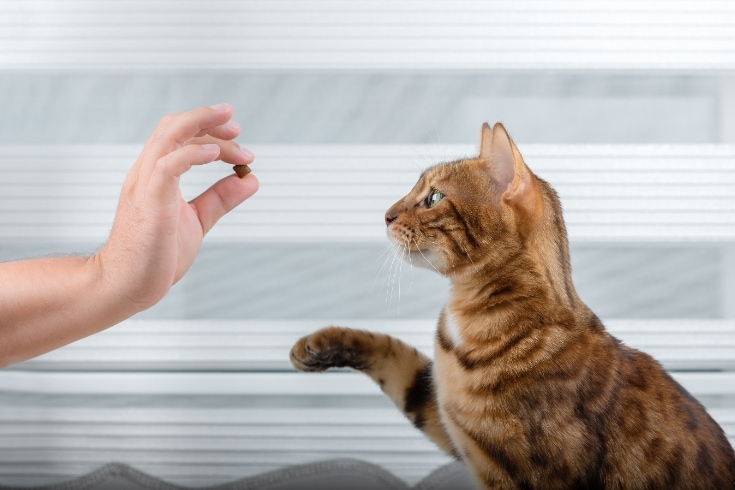
Your cat must understand that you want her to use the scratching post, so when you see your cat using the scratching post, immediately praise and reward her with treats or your affection. Positive reinforcement will help to reinforce that good behavior and encourage your cat to use the post more frequently.
Redirect Your Cat If It Scratches Inappropriate Surfaces
If you catch your cat scratching the furniture or another inappropriate surface, gently redirect her to the scratching post by placing her near it and encouraging her to scratch the post instead.
Repeat Positive Reinforcement Consistently
The key to successful training is consistency, so every time your cat uses the scratching post, provide positive reinforcement through rewards such as treats. That way, your cat will associate using the scratching post with a positive experience and will be more likely to use it in the future.
Gradually Move The Post If Needed
If your first choice of location for the scratching post doesn’t attract your cat, consider moving it to a different part of the house. Make the change gradually so that your cat doesn’t get confused, and ensure that she can see the scratching post clearly in its new place.
Introduce More Posts In Different Locations
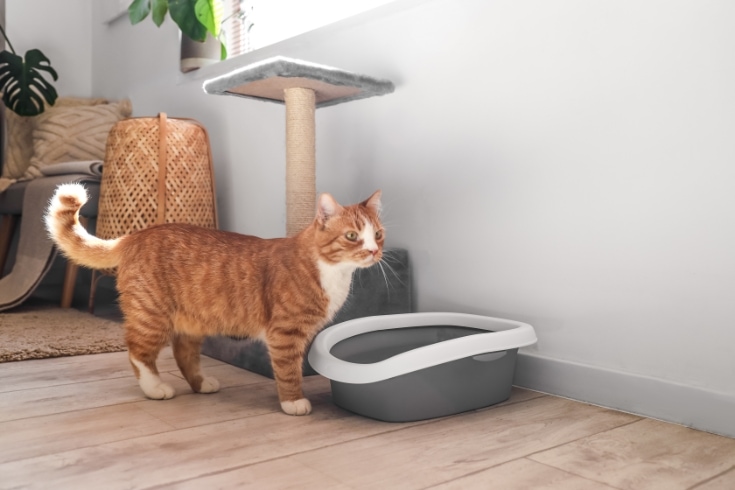
If you have multiple cats, having several scratching posts in different areas of your home is a good idea. That provides your cats with plenty of options for places to scratch and helps prevent territorial squabbling that might develop if you only have one scratching post.
Maintain The Post Regularly
Scratching posts don’t generally get dirty, although they become frayed and worn, so you must trim any frayed or loose threads to keep the post in good condition and tidy.
A well-maintained scratching post is much more appealing to your cat than a scruffy, worn-out one, reducing the likelihood of your pet choosing something inappropriate to scratch on.
Common Challenges In Scratching Post Training And Their Solutions
Challenges in scratching post training can include many factors, including resistance to training, your cat losing interest in the post and returning to scratching on the furniture, and only using the post when you encourage her to.
Throughout your cat scratching post training, remember that positive reinforcement, patience, and consistency are all crucial to success. Never punish or yell at your cat for scratching something she shouldn’t, as that will likely make your cat afraid and anxious, exacerbating the problem and hindering the training process.
Cat Shows Uninterest In The Scratching Post
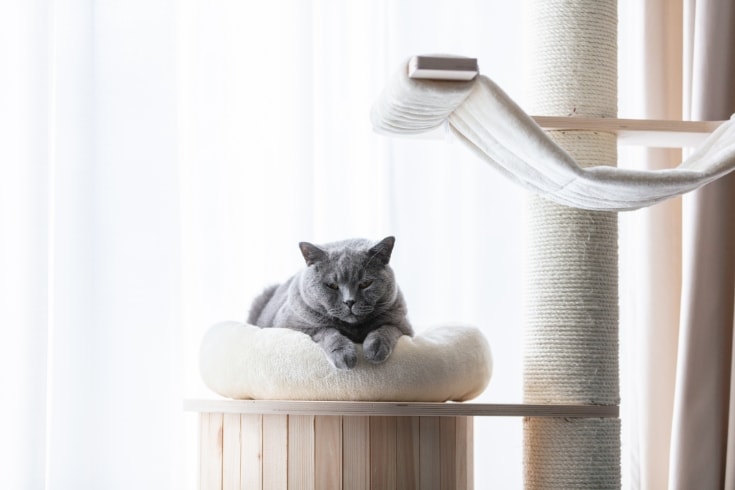
Some cats initially show no interest whatsoever in the new scratching post, making it challenging to redirect their scratching behavior.
Check that you have placed the scratching post in an appealing location close to somewhere your cat spends lots of her time. Cats often scratch to mark their territory, so putting the post close to a favorite hang-out area can help.
You could also try using treats or catnip to encourage your cat to investigate the scratching post.
Cat Returns To Old Scratching Surfaces
Sometimes, your cat might carry on scratching furniture or other inappropriate surfaces even after you’ve provided her with her own scratching post. Fortunately, you can do a couple of things to keep your kitty cat on the straight and narrow!
First, try covering scratched surfaces with plastic sheeting, aluminum foil, or double-sided tape to make the surface less attractive to the cat. In addition, make the scratching post more appealing to your cat by using treats and catnip and using positive reinforcement when the cat uses it.
Cat Topples Over The Scratching Post
A large, energetic cat might top all over a lightweight scratching post, especially when scratching particularly enthusiastically.
When buying a scratching post for your cat, be sure to choose a heavy, sturdy one or one that you can secure to the wall or floor. That should prevent the post from tipping over during use, making it more appealing and safer for the cat to scratch.
Cat Only Uses The Post When Encouraged
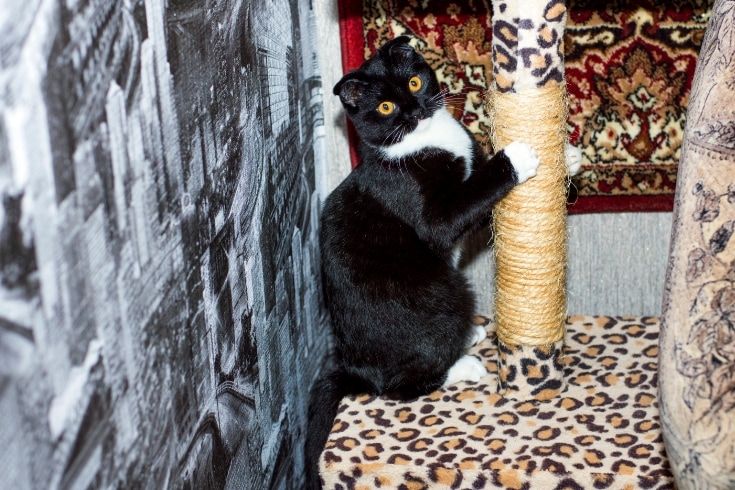
In this scenario, the cat might only use her scratching post when you or another family member specifically encourages her to do so.
Although encouragement is initially vital during training, it’s crucial to gradually reduce that as the cat gets the idea and starts using the scratching post routinely. Positive reinforcement involves rewarding the cat with verbal praise and treats when she uses the post, but over time the cat should learn to use it without you constantly encouraging her.
Multiple Cats Fighting Over One Post
As mentioned previously, cats use scratching to mark their territory. If you have several cats living in one house, that will almost inevitably lead to conflict if they only have one scratching post between them.
The simplest way to prevent squabbles is to buy at least one scratching post per cat and locate the posts in different places around your home so that each cat can claim her territory, using the scratching post as a marker.
Cat Loses Interest Over Time
Sometimes, your cat might lose interest in her scratching post and, in the worst-case scenario, will return to scratching your furniture or floor coverings. That is generally because the scratching post no longer satisfies your cat’s needs, probably because it is worn out and needs replacing.
You can keep your cat interested in the scratching post by maintaining it properly and replacing it when necessary.
Scratching Post Wears Out Quickly
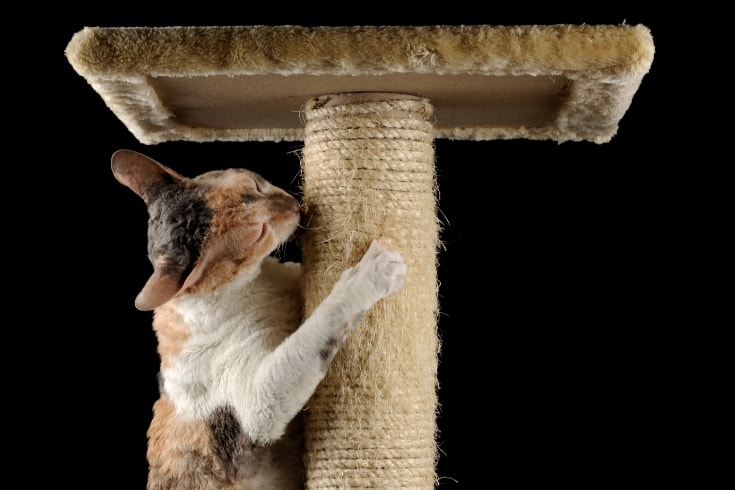
The materials used to make cheap scratching posts are typically of poor quality and don’t last long.
When you buy a replacement scratching post, try to have enough in your budget to afford a high-quality one made from durable, heavy-duty materials and built to last. Scratching surfaces covered with double layers of sisal, jute, or carpet tend to last the longest, and a wooden or double cardboard base is less likely to weaken and topple over.
Cat Prefers Furniture Over Post
As mentioned previously, some cats might still prefer to scratch your furniture even if you provide them with a high-quality scratching post.
You can try to make your furniture less appealing by covering it with materials cats generally, including double-sided tape, aluminum foil, or plastic. In addition, make the scratching post more enticing by using treats, toys, or to attract your cat to it.
Be patient and consistent in redirecting your cat’s behavior toward the post and away from your furnishings, and if the undesirable behavior persists, consider using a cat deterrent spray on items you want your cat to keep away from.
Cat Prefers Different Texture
Individual cats have different preferences when it comes to scratching textures and might not like the surface of the scratching post you have thoughtfully provided for them.
Try experimenting with different scratching post materials, including sisal, cardboard, carpet, or wood. Observe your cat to see which texture she prefers and provide a scratching post that matches her preference.
Cat Scratches At The Carpet
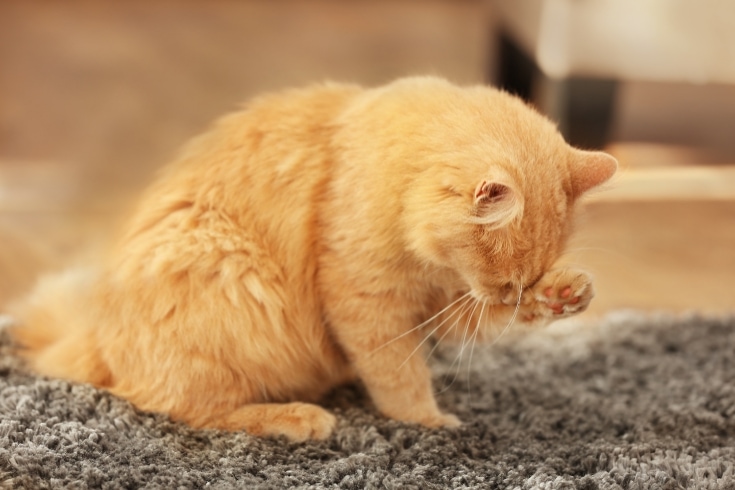
Some cats develop a destructive habit of scratching at carpets, especially when the carpet meets a doorway or in the corner of a room.
In that case, try redirecting the cat’s attention to a scratching post or scratching mat. if that doesn’t work, cover the affected area of the carpet with a large, sturdy mat or a carpet runner placed with the nubby side upward, as cats usually hate that texture.
Position your scratching post close to the damaged carpet to encourage your cat away from the area she has marked so that, hopefully, she will use the scratching post to mark her claimed territory instead.
What Is The Role Of Patience And Consistency In Successful Training Scratching Post Training?
Training your cat to use her scratching post instead of your furniture or other inappropriate surfaces can be challenging, but with the right approach, patience, and consistency, it can be accomplished.
Training your cat to do something can take time, so you must be patient and not try to rush things. Cats are typically very independent creatures with unique personalities, and some may use the scratching post more quickly than others.
Take your time, reward small degrees of progress and tiny improvements to encourage that positive behavior, and celebrate with your cat each time she uses the scratching post, even if it’s just with a tiny scratch.
Never yell at your cat or punish her if she gets it wrong, as that could make your cat afraid of you and will undoubtedly set back your scratching post training program.
Cats learn through repetition, so it’s essential that you consistently reinforce the desired behavior by rewarding your cat with praise and rewards. Locate the scratching post in an easily accessible location where your cat spends most of her time to ensure your cat is more likely to use the post regularly.
Every time you catch your cat scratching the furniture or some other inappropriate surface, gently redirect them to the scratching post.
What Are The Best Cat Scratching Posts For Your Cats?
Without further ado, let’s get our claws into these reviews of five of the best cat scratching posts for cats that are currently available on the market.
1. Made4Pets Cat Scratching Post
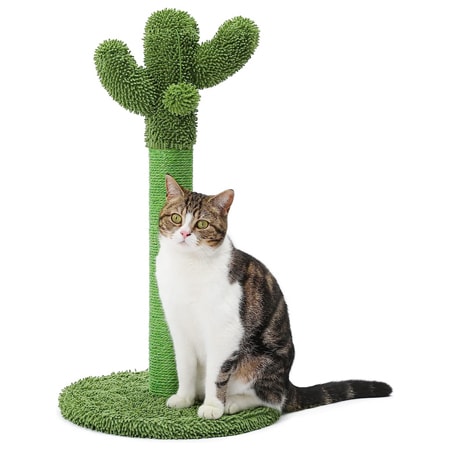
Available in 3 sizes
Sisal covered
Danging ball feature
This green cactus design scratching post features a dangling ball for your cat to play with, is covered with natural sisal, and comes in three sizes to suit cats of all sizes and ages.
The round base is covered with chipboard and covered with soft carpet that won’t damage your floors and keeps the scratching post stable so it won’t wobble or tip over.
You get all the tools you need included with the product, and the simple three-step design makes it easy to assemble the scratching post in a matter of minutes.
PROS
- Hard-wearing sisal covering
- Attractive novelty design
- Stable design won’t tip over
CONS
- Not everyone appreciates a green cactus in their living room!
2. PETEPELA Cat Scratching Post
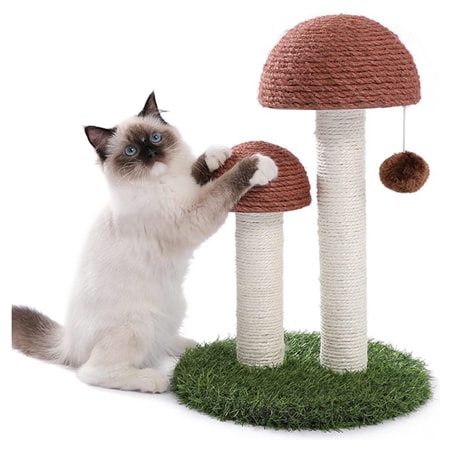
11.81″L x 11.81″W x 18.9″H
Sisal covered
Danging ball feature and cute mushroom design
This gorgeous cat scratching post gives your kitty cat double the fun with its two mushrooms! The posts are covered in hand-woven sisal for superior durability and less fraying and shedding than other similar products.
The product features a dangling ball for extra fun, and the two scratch posts are different heights so that cats of all sizes can use them easily.
PROS
- High-quality, durable materials
- Hanging ball feature
- Two different height posts to suit cats of all sizes
CONS
- Quite large, so you’ll need plenty of space
3. AIWIKIDE 002G Cat Tree
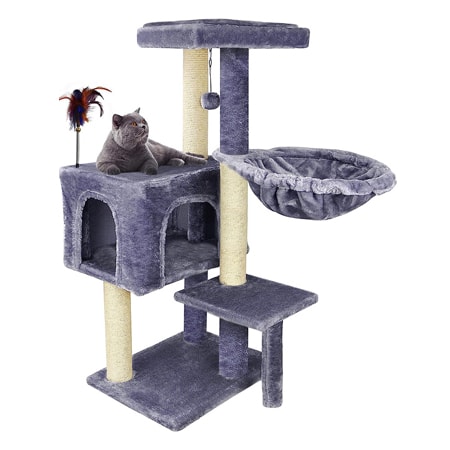
25.98″L x 16.14″W x 35.43″H
Sisal covered
Fantastic cat tower design
In addition to scratching, cats love to climb, and this incredible cat tower provides multiple jute scratching posts, three levels to climb up and down, and a comfy, faux fur hideout in which to nap!
There’s a hanging ball feature for your cat to play with and a soft, plushy hammock to snooze in when playtime is over. If your cat prefers, she can recline on the top platform to enjoy the view outside your window.
PROS
- Excellent value
- Multiple features for your pampered pet to enjoy
- Well-made, durable jute-covered scratching posts
CONS
- Pricey if you’re on a limited budget
4. Frisco 33.5-in Sisal Cat Scratching Post
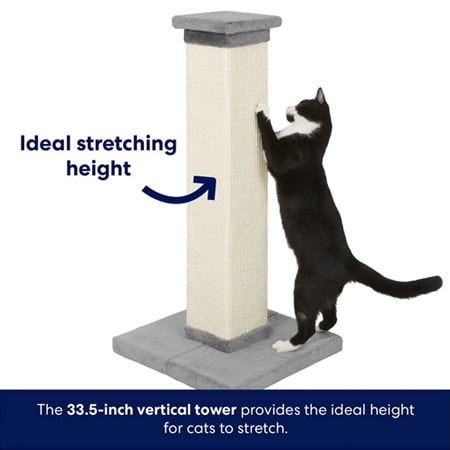
33″ vertical tower
Dual-textured sisal covered
Robust large cat tower design
This robust cat scratching post tower is made from double-layer baseboard for superior stability, so you can be sure it won’t topple over even under the most determined claw sharpening!
The dual textured 360-degree sisal covering stands up to repeated use, and when your cat’s finished her manicure, she can enjoy a bird’s eye view from the comfy, plush perch at the top of the tower.
The tower is easy to assemble and comes complete with a clear instruction booklet and all the tools you need.
PROS
- Excellent value
- Perfect for larger cats
- Robust sisal-covered scratching post
CONS
- Takes up quite a lot of space in a small apartment
5. SmartyKat Scratch Up+
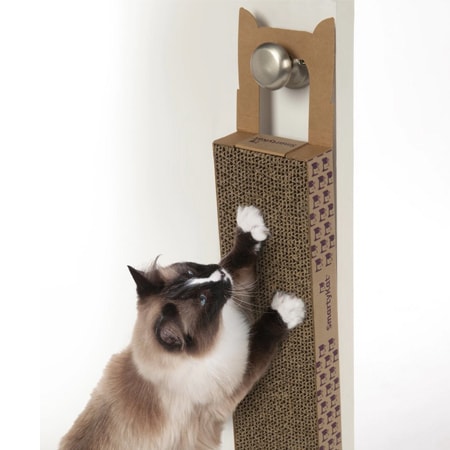
5.5” x 2.12” x 23.4”
Space-saving hanging design
Catnip infused to encourage scratching
This unique scratching post design can be hung from a doorknob or laid flat on the ground, so it’s ideal for tiny kittens and senior cats that lack mobility.
The heavy-duty corrugated cardboard scratching surface is designed to mimic natural tree bark, which your cat would normally use as a scratching spot. There’s highly concentrated catnip between each cardboard layer to encourage scratching and make using the post extra fun for your kitty.
PROS
- Clever, space-saving design
- Catnip scent released with each scratch
- Hang vertically or lay flat on the floor, so perfect for older cats with mobility issues
CONS
- Perfect for homes with limited space
FAQs
Here are the answers to some of the questions most often asked by frustrated cat owners about teaching their pets to use a scratching post.
What Type Of Scratching Post Is Best For My Cat?
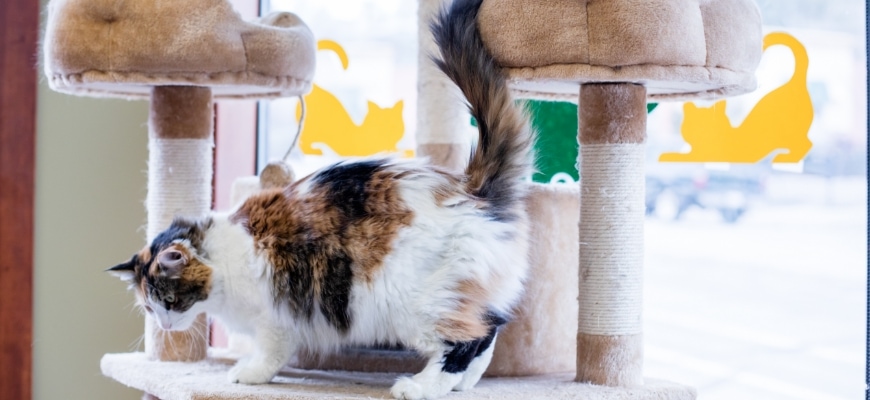
Cats have different preferences when it comes to scratching posts, so it could take a few attempts to find the ideal produce.
However, most cats enjoy using a well-made, robust scratching post that doesn’t wobble around when the cat scratches on it and offers a few hanging toys and a padded perch to sit on.
How Do I Get My Cat To Use A New Scratching Post?
Cats use scratching as a way of marking new territory, and the first thing my two cats did when I moved house was to immediately make a point of scratching on their scratching post.
You can get your cat to use a new scratching post by placing it in a room she enjoys spending time in. Try scenting the scratching post with catnip or scattering a few treats on the perches to encourage your cat to explore and investigate her new toy.
Where Should I Place The Scratching Post?
You should place the scratching post in a room where your cat spends much of her time and is likely to want to mark it as her territory. If your cat habitually scratches a particular piece of furniture, try placing the scratching post next to it to provide your kitty with an alternative.
Choose a spot that’s easily accessible for your cat and where the scratching post won’t be in the way of other household members. If the scratching post has a viewing perch, a good spot might be near a window so that your cat can enjoy the view outside from a warm, comfortable place.
Can I Train An Older Cat To Use A Scratching Post?
You can train an older cat to use a scratching post, although that might take a little longer than it would to train a kitten or young cat.
That’s simply because older cats can be too set in their ways to appreciate a change in behavior. For example, my old housecat Harry loved to scratch on my coir doormat and showed no interest in the beautiful new scratching post I bought for him, despite my best efforts to train him to use it.
Eventually, I admitted defeat. After all, the doormat was a whole lot tougher than old H’s claws and was undamaged despite his best efforts, so I left him to it.
How Many Scratching Posts Do I Need In My Home?
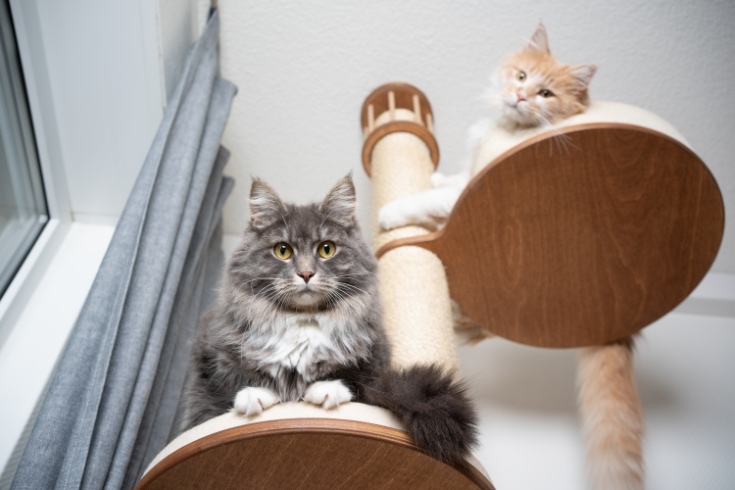
If you have a multi-cat household, you ideally want to provide each cat with her own scratching post located in a room she favors. That helps prevent conflicts and squabbles over the posts and allows the cats to claim territory without fighting for it.
Can I Use Toys Or Treats To Encourage My Cat To Use The Scratching Post?
Yes, positive reinforcement encourages the use of rewards in the form of treats, praise, and toys. So, by all means, tempt your cat to use her scratching post by scattering treats around it, sprinkling it with catnip, or using a favorite toy to pique your pet’s interest.
How Long Does It Usually Take For A Cat To Start Using A Scratching Post Regularly?
How long it usually takes a cat to start using a scratching post depends on the cat’s personality, how much time you can devote to her training and your pet’s age.
For example, younger cats tend to learn more quickly than older ones and shelter cats can be set in their ways and take longer to retrain.
All my cats, except one old shelter cat, started using their scratching posts almost immediately and with very little training, but I guess I’ve been lucky!
Should I Replace The Scratching Post Once It Is Worn Out?
Yes, I would recommend you replace a worn-out scratching post with a new one, otherwise, your cat might transfer her attention to one of your sofas or the carpet!
Go for a similar style of scratching post that you know works for your cat rather than changing things up.
Is There A Specific Time Of Day Best For Training My Cat To Use The Scratching Post?
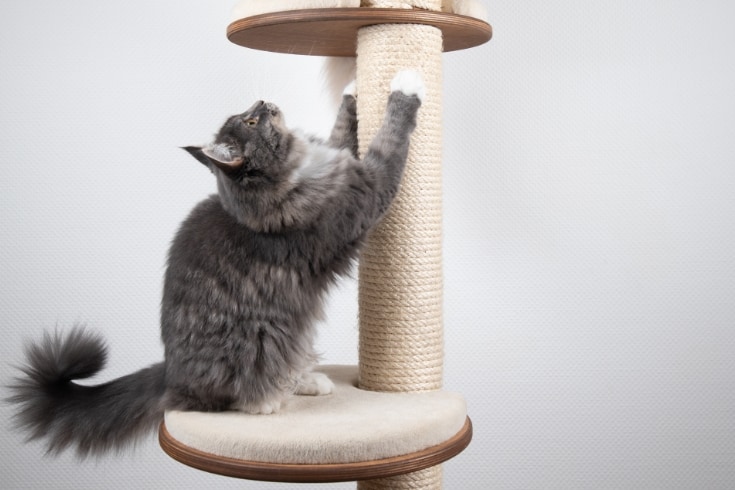
Although no specific time of day is best for training your cat to use her scratching post, most cats enjoy a scratch just after they’ve woken up, so you could time your training sessions to coincide with that.
Again, every cat is different, so you need to figure out when your cat is most receptive to training and go with that.
Can Multiple Cats Share The Same Scratching Post?
In multicat households like mine, you might be fortunate and have cats that are happy to share one scratching post. Mine do, but that’s probably because they are brother and sister.
However, many cats don’t like to share their scratching territory, so ideally, you should have one scratching post for every cat in your home, plus an additional one.
My Cat Is Declawed, Does It Still Need A Scratching Post?
Yes, declawed cats still have the natural desire to mark their territory and scratch, so even if your cat is declawed, she will still benefit from having a scratching post.
In addition, scratching serves as a form of exercise, allowing your cat to stretch her muscles and work out her upper body on the scratching post. That’s a natural stress reliever for cats and helps to reduce anxiety and get rid of pent-up energy.
Did you know that cats have scent glands in their paws? Scratching allows the cat to leave their scent in a specific place, marking that spot as their territory, which helps them feel secure and at home. So, a declawed cat can still use her paws to mark her patch even though she can no longer scratch.
Conclusion
Scratching is a natural behavior that offers many benefits to your cat, including allowing her to mark her territory, get vital physical and mental stimulation, keep her claws in good condition, and relieve stress. Providing your cat with a scratching post and teaching her to use it can also prevent your pet from damaging your furniture, floor coverings, and skirting boards.
There are many different styles of scratching posts to choose from, including those with multiple posts, perches, and hammocks to rest between scratching bouts. Observe your pampered pet to find out what kind of scratching surface she prefers, and buy a high-quality, well-made scratching post that suits her needs.
If you have more than one cat, it’s best to provide a scratching post for each of your pets in different locations around your home to help prevent territorial squabbles.
You can enrich your cat’s environment by providing her with a scratching post and protecting your home furnishings from damage, leading to a more harmonious relationship with your feline friend. Training your cat to use the scratching post is pretty straightforward, provided you’re patient, consistent, and use positive reinforcement, so why not get started today?
If you already trained your cat to use her scratching post, we’d love to hear about your experiences and learn your top training tips. Why not tell us about your furry friend in the comments box below?